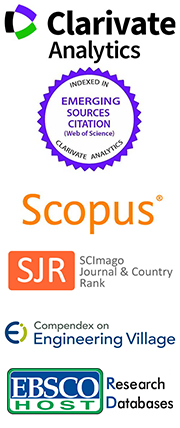A Study on Paddy Drying with an Automated Fluidized Bed Dryer
Abstract
Keywords
Full Text:
PDFReferences
Tiwari G.N. and S. Sarkar. 2020. Review on recent advances in solar drying technologies for agricultural produce. Renewable and Sustainable Energy Reviews 122: 109734.
Anwar S., Rehman F., and Khan I., 2021. Performance analysis of hybrid solar-electric dryer for agricultural products. Renewable Energy Focus 38: 52–61.
Ying C. and R. Spang. 2024. Comparative energy analysis of paddy drying technologies in Southeast Asia. Renewable Agriculture and Food Systems 39(1):120–129. https://doi.org/10.1017/raf.2023.45.
Luthra K., 2021. Developing a lab-scale fluidized bed dryer system to enhance rough rice drying process. MS Thesis (published). University of Arkansas, Fayetteville,USA. https://scholarworks.uark.edu/etd/4138.
Wazed M.A., Mozumder N.H.M.R., and Sarker M.S.H., 2022. Head rice yield of paddy dried in two stage and conventional drying methods. Agricultural Engineering International: CIGR Journal 24(3): 190–200.
Choicharoen K., 2024. Energy efficiency of paddy dehydration process using vortex dryer. Journal of Food Process Engineering 14(4): 99–107.
Nebrida A.P., 2024. Smart integration in agriculture: An Arduino-driven rice grain dryer for optimal post-harvest management. Journal of Electrical Systems and Information Technology 11: 46. https://doi.org/10.1186/s43067-024-00170-0.
Herani N., Rahmat S., and Prasetia V., 2023. Monitoring of rice dryer machine using tray dryer method. Infotekmesin 14(2): 311–317. https://doi.org/10.35970/infotekmesin.v14i2.1915.
Çengel Y.A. and A.J. Ghajar. 2020. Heat and mass transfer: Fundamentals and applications (6th ed.). New York: McGraw-Hill Education.
Joycharoen K., 2020. Performance and energy consumption study of a swirl-fluidized bed dryer for paddy. Master’s Thesis, King Mongkut’s University of Technology North Bangkok, Bangkok, Thailand.
Wormsbecker M., Pugsley T., and Tanfara H., 2016. The influence of distributor design on fluidized bed dryer hydrodynamics. In Proceedings of the 12th International Conference on Fluidization, Gyeong-ju, Korea, 22–27 May.
Kunii D. and O. Levenspiel. 1991. Fluidization engineering (2nd ed.). Oxford: Butterworth-Heinemann.
Chupawa P., Gaewsondee T., and Duangkhamchan W., 2021. Drying characteristics and quality attributes affected by a fluidized-bed drying assisted with swirling compressed-air for preparing instant red jasmine rice. Processes 9(10): 1738. https://doi.org/10.3390/pr9101738.
Ayensu A., 1997. Dehydration of food crops using a solar dryer with convective heat flow. Solar Energy 59: 121–126. https://doi.org/10.1016/S0038-092X(96)00130-2.
Yiotis A., Tsimpanogiannis I., Stubos A., and Yortsos Y., 2006. Pore-network study of the characteristic periods in the drying of porous materials. Journal of Colloid and Interface Science 297(2): 738–748. https://doi.org/10.1016/j.jcis.2005.11.043.
Li G., Kaixuan X., Qichao Y., Yuangyang Z., and Liansheng L., 2022. Flow field and drying process analysis of double-layer drying chamber in heat pump dryer. Applied Thermal Engineering 118261. https://doi.org/10.1016/j.applthermaleng.2022.118261.
Aranha A., Ferrari A.L., Bissaro C.A., Matias G., Defendi R., Paschoal S.M., and Jorge L.M., 2023. Mathematical modelling of wheat drying by fractional order and assessment of transport properties. The Canadian Journal of Chemical Engineering. https://doi.org/10.1002/cjce.25081.
Yahya M., Fahmi H., Fudholi A. and Sopian K., 2018. Performance and economic analyses on solar-assisted heat pump fluidised bed dryer integrated with biomass furnace for rice drying. Solar Energy 174: 1058-1067. https://doi.org/10.1016/j.solener.2018.10.002.
Zhu D., Wang T., Liu X., Bi J., Zhang W., Zeng X., Wang P., and Shu Z., 2024. Quality changes in Chinese high-quality Indica rice under different storage temperatures with varying initial moisture contents. Frontiers in Nutrition 11: 1334809. https://doi.org/10.3389/fnut.2024.1334809.
Ondier G., Siebenmorgen T., and Mauromoustakos A., 2010. Low-temperature, low-relative humidity drying of rough rice. Journal of Food Engineering 100: 545–550. https://doi.org/10.1016/j.jfoodeng.2010.05.004.
Mondal M.H.T. and M.S.H. Sarker. 2024. Comprehensive energy analysis and environmental sustainability of industrial grain drying. Renewable and Sustainable Energy Reviews 114442. https://doi.org/10.1016/j.rser.2024.114442.
Ying T. and E. Spang. 2024. Paddy drying technologies: A review of existing literature on energy consumption. Processes 12(3): 532.
DOI: https://doi.org/10.64289/iej.25.03A11.7634243


